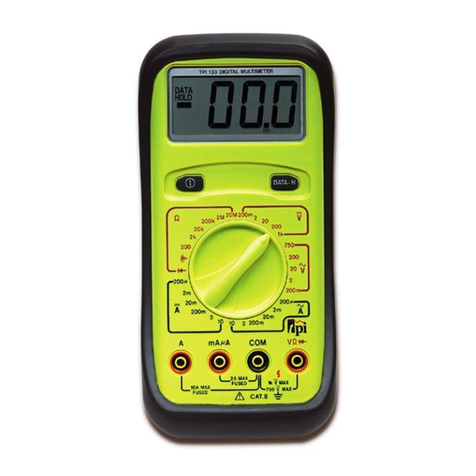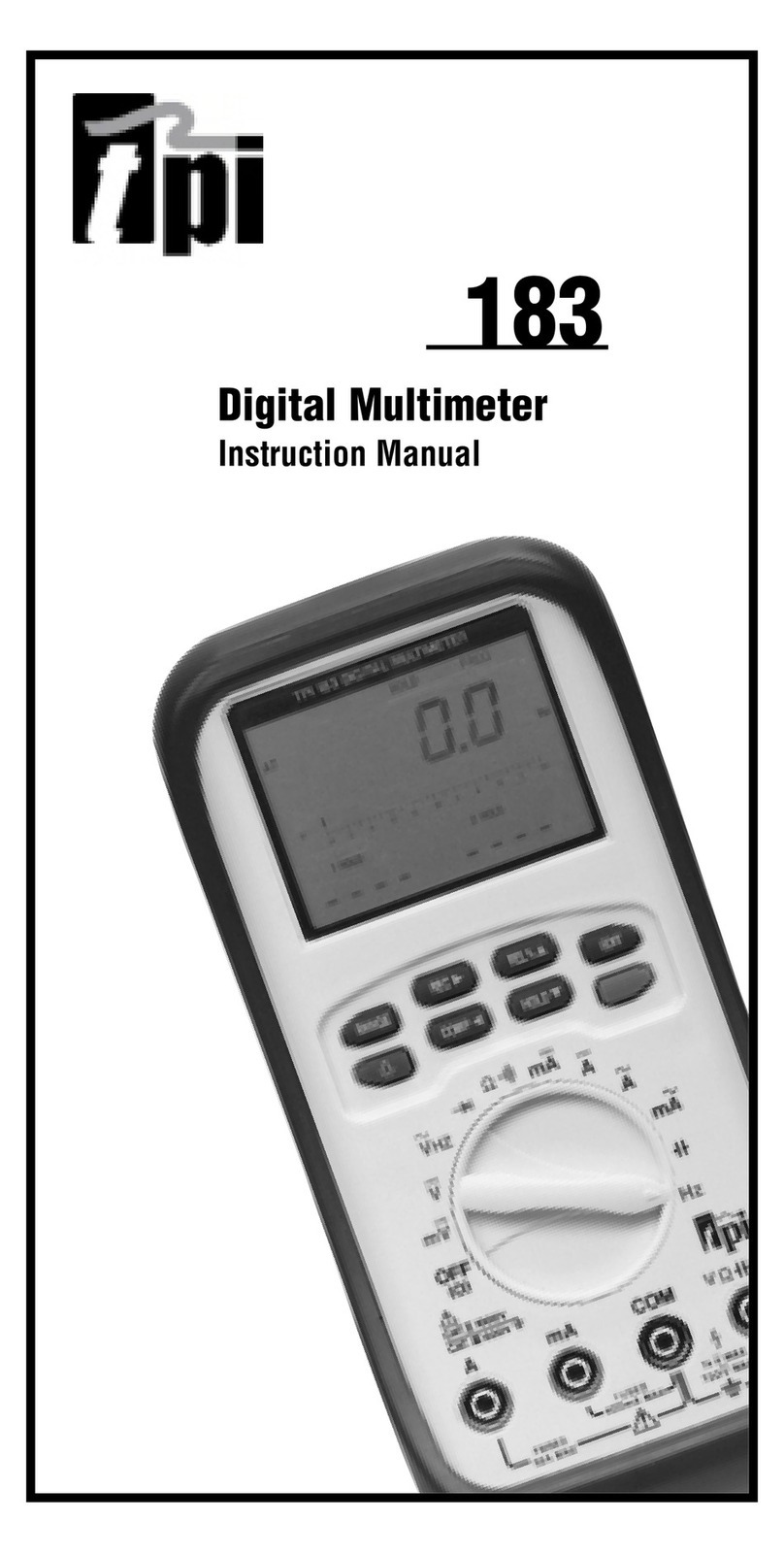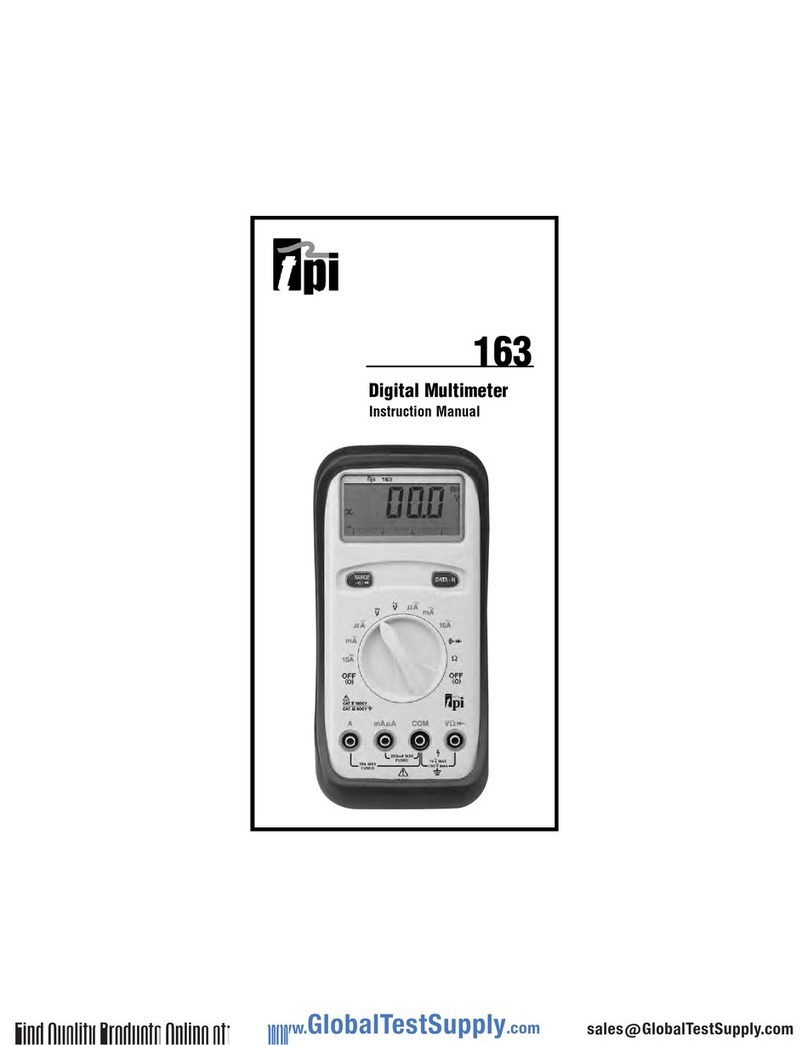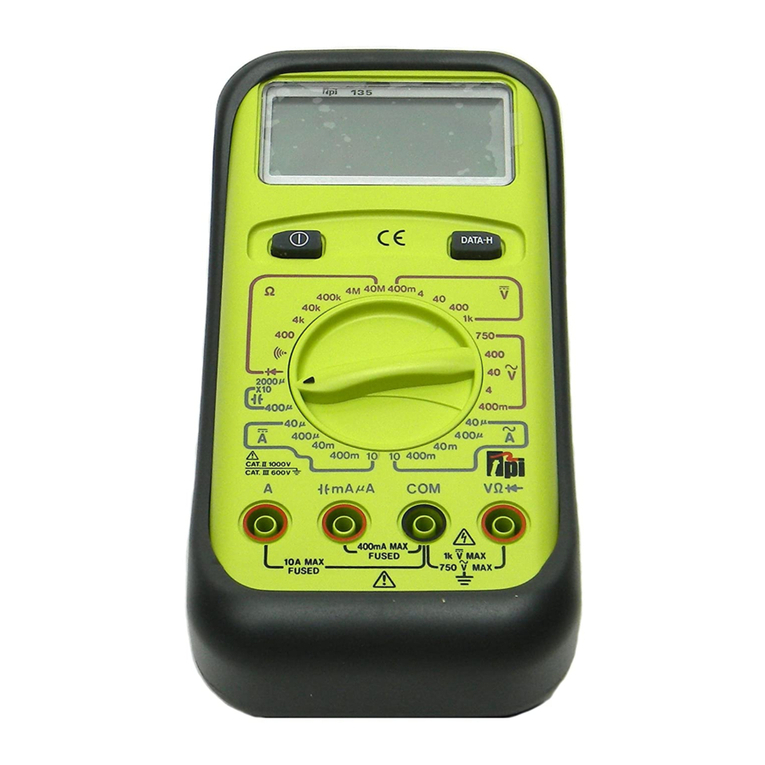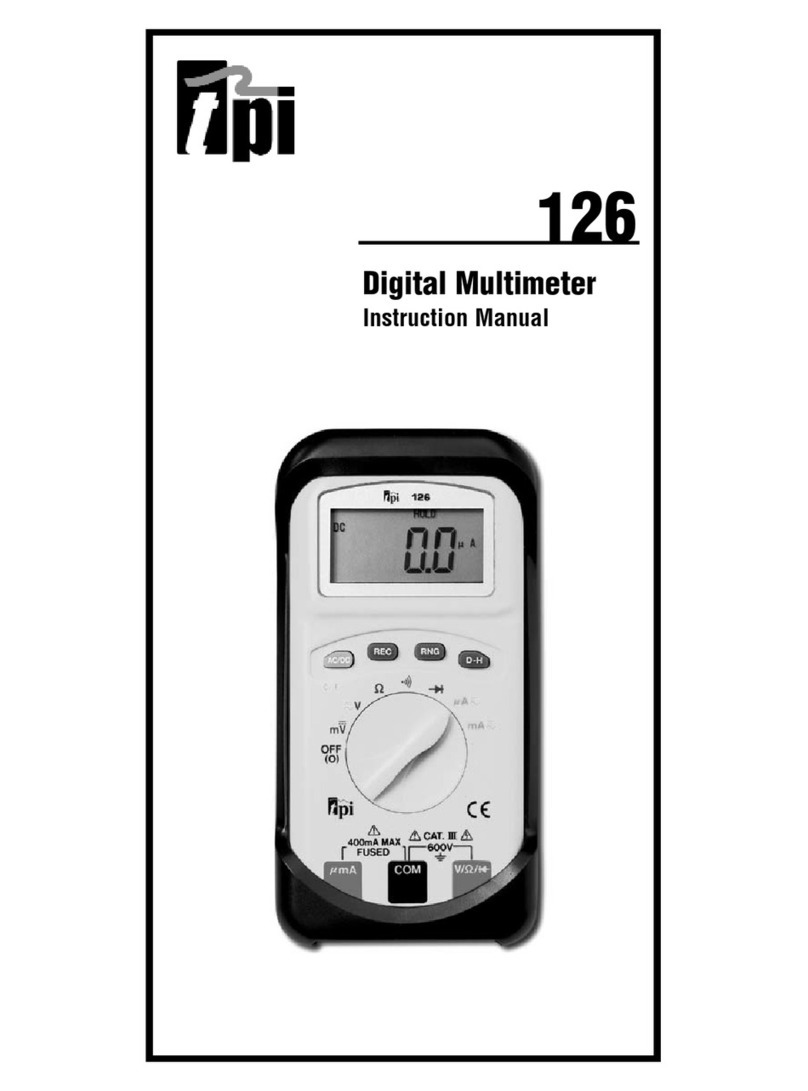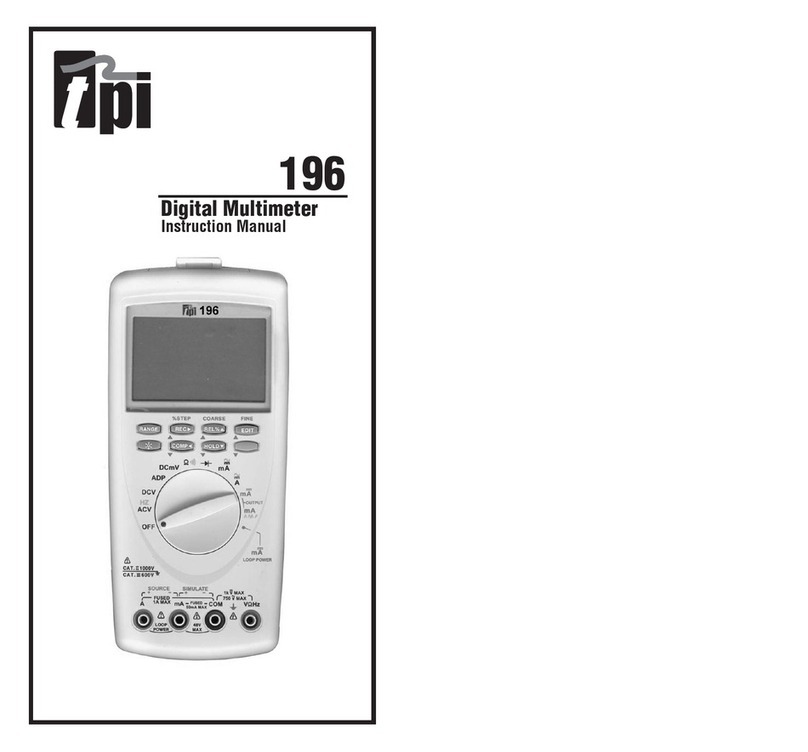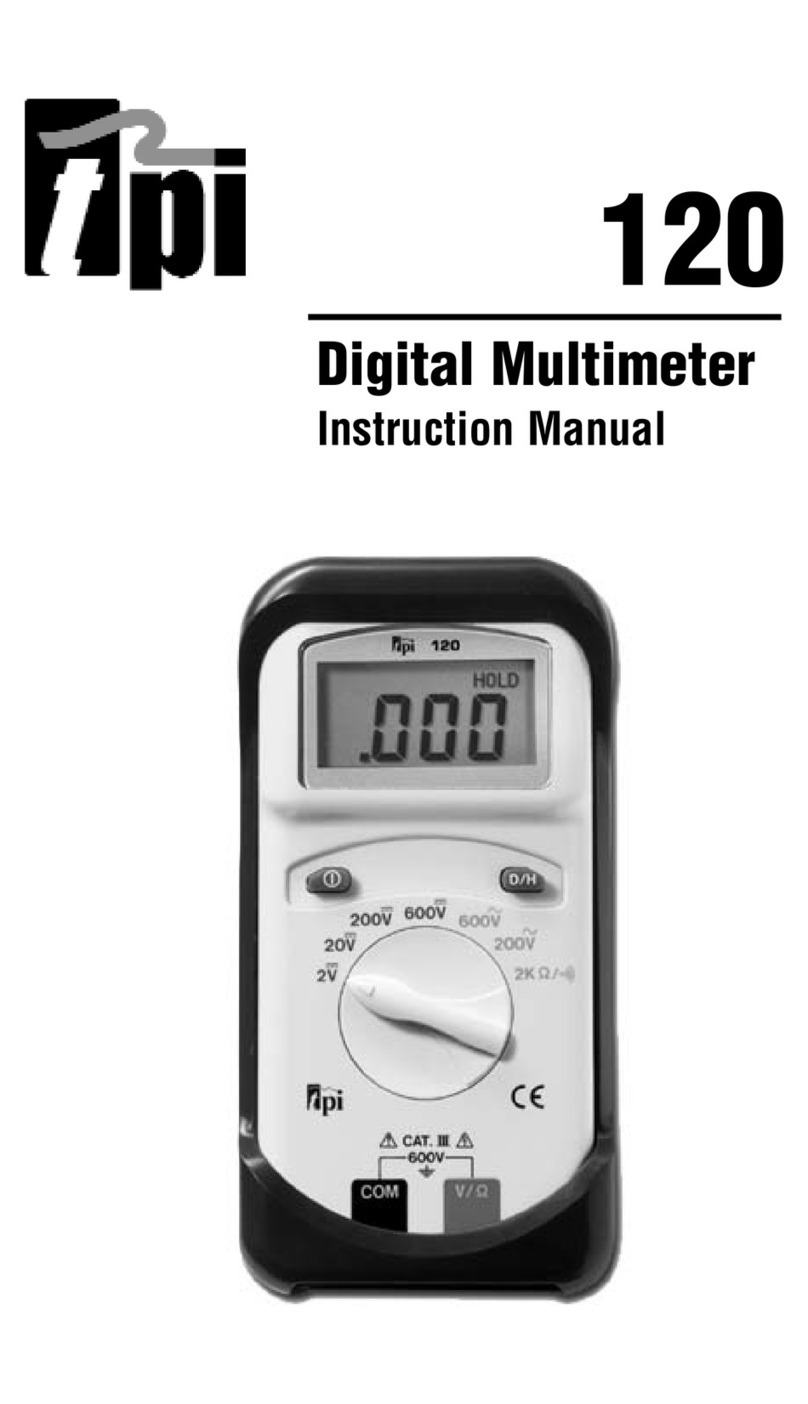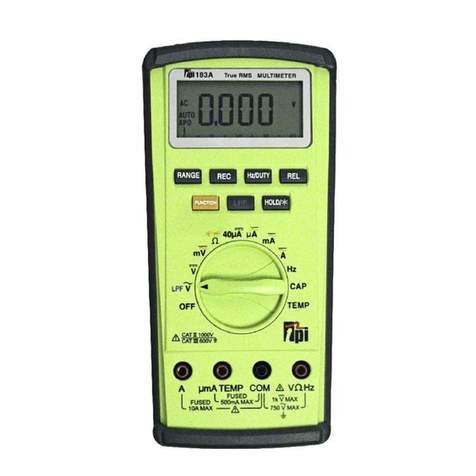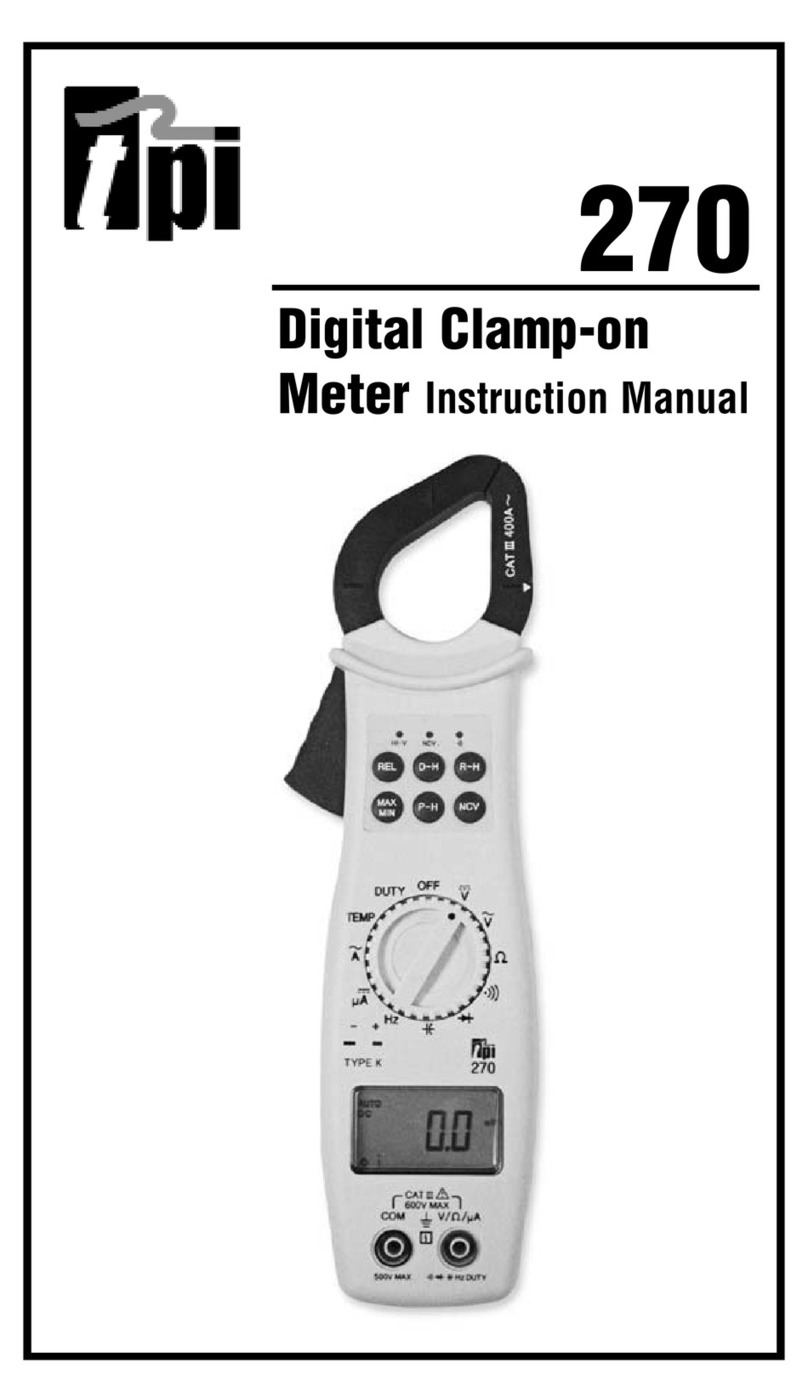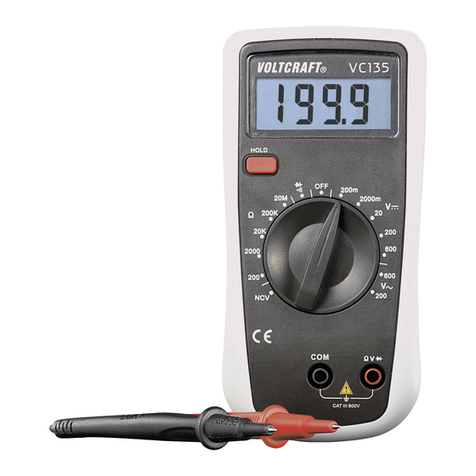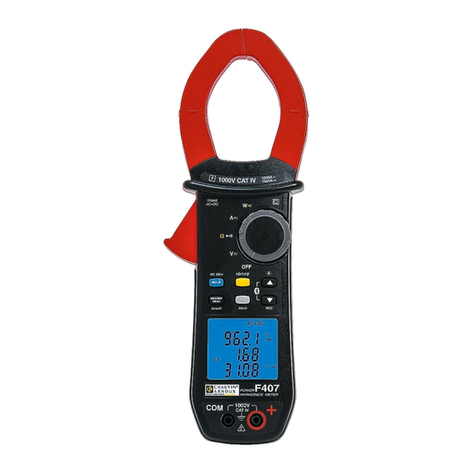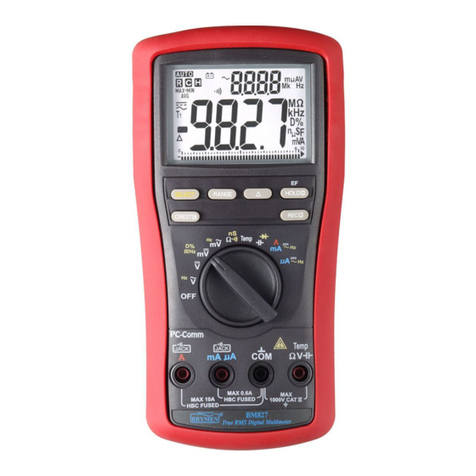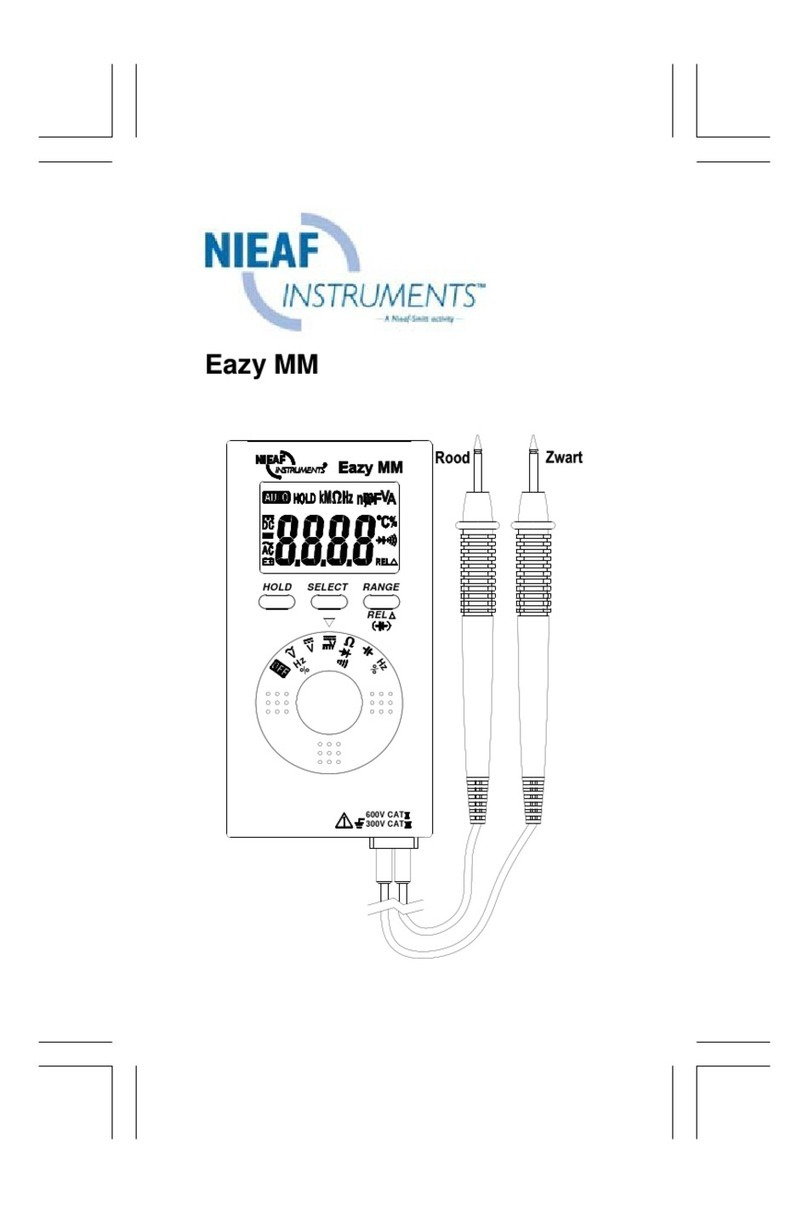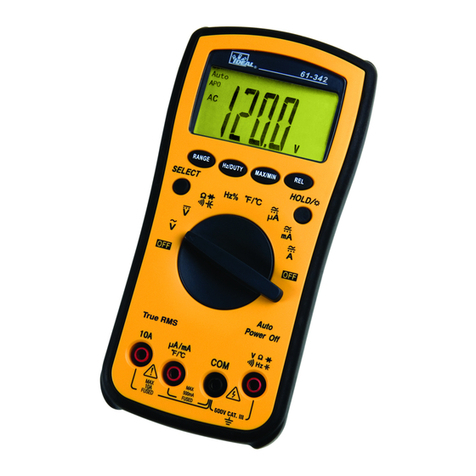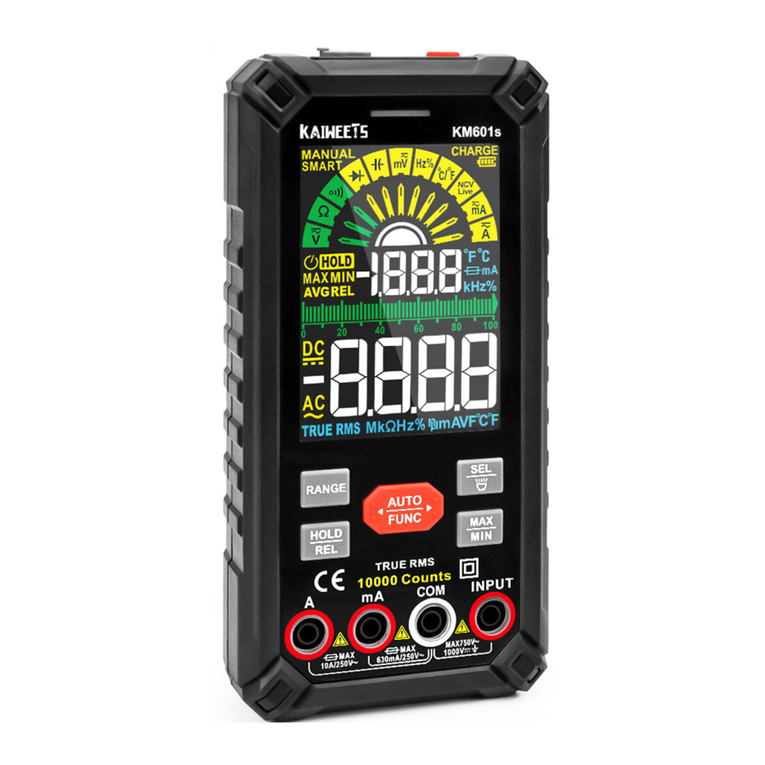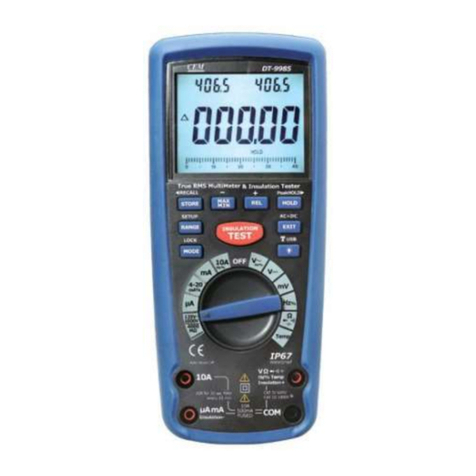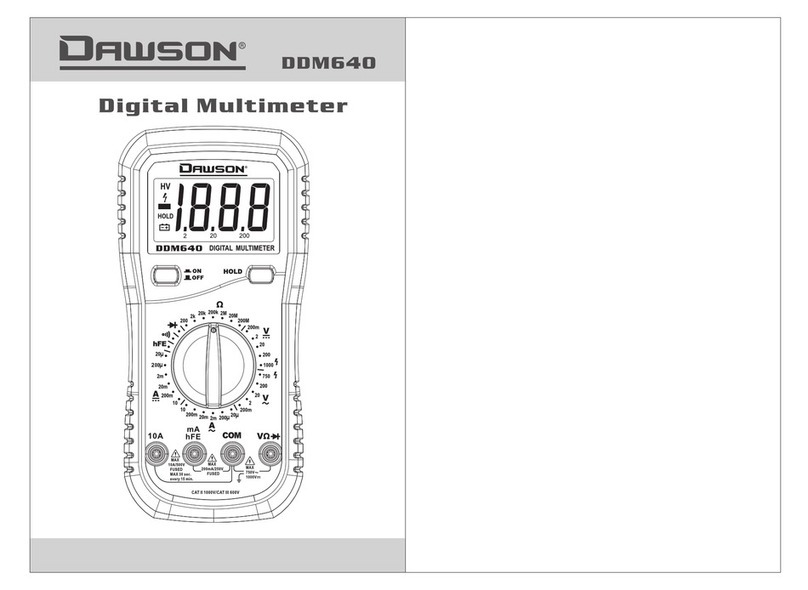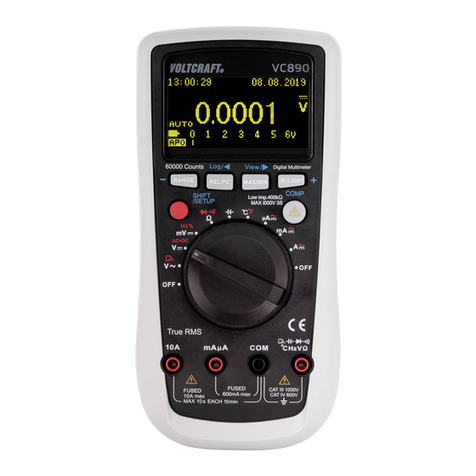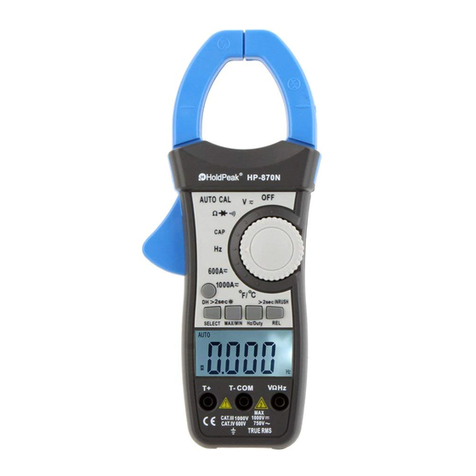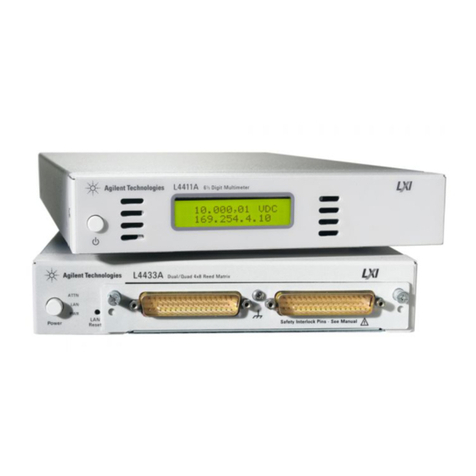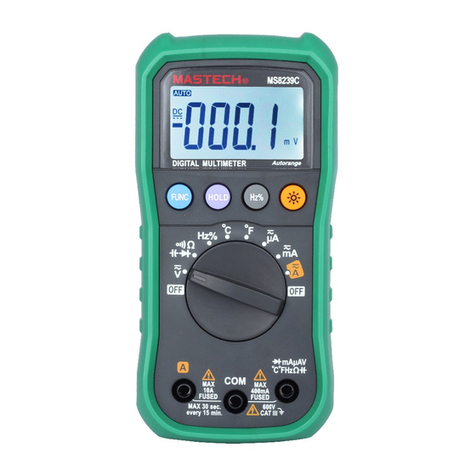TPI 135 User manual

135
Digital Multimeter
Instruction Manual
www. .com information@itm.com1.800.561.8187

32
TABLE OF CONTENTS
page
A. INTRODUCTION
1. Congratulations . . . . . . . . . . . . . . . . . .3
2. Product Description . . . . . . . . . . . . . .3
3. EC Declaration of Conformity . . . . . . . .4
B. SAFETY CONSIDERATIONS . . . . . . . . . . . .5
C. TECHNICAL DATA
1. Features and Benefits . . . . . . . . . . . . .6
2. Product Applications . . . . . . . . . . . . . .7
2. Specifications . . . . . . . . . . . . . . . . . . .8
D. MEASUREMENT TECHNIQUES
1. Controls and Functions . . . . . . . . . .10
2. Step by Step Procedures:
a) Measuring DC Volts . . . . . . .11
b) Measuring AC Volts . . . . . . .12
c) Measuring DC Amps . . . . . .13
d) Measuring AC Amps . . . . . .15
e) Measuring Resistance . . . . .17
f) Measuring Diodes . . . . . . . .18
g) Measuring Capacitance . . . .19
h) Continuity Buzzer . . . . . . . .20
i) Data Hold . . . . . . . . . . . . . . 20
E. ACCESSORIES . . . . . . . . . . . . . . . . . . . . .21
F. MAINTENANCE . . . . . . . . . . . . . . . . . . . .22
G. TROUBLE SHOOTING GUIDE . . . . . . . . . .23
A. INTRODUCTION
1. Congratulations!!
Thank you for purchasing TPI brand products. The meter is
easy to use and is built to last. It is backed by a 3 year
limited warranty. Please remember to complete and return
your product warranty registration card.
2. Product Description
The 135 is a hand held manual ranging DMM. It features
extra large numerals on the LCD, and Data Hold for all
functions and ranges. The 135 is an affordable choice
offering measurements in all of the basic electrical
functions.
The 135 comes complete with the following:
135 Instrument
Rubber Boot
Test Lead Set
Instruction Manual
Battery
www. .com information@itm.com1.800.561.8187

54
B. SAFETY CONSIDERATIONS
WARNING: Please follow manufacturers test
procedures whenever possible. Do not attempt to
measure unknown voltages or components until a
complete understanding of the circuit is obtained.
GENERAL GUIDELINES
ALWAYS
• Test the 135 before using it to make sure it is
operating properly.
• Inspect the test leads before using to make sure
there are no breaks or shorts.
• Double check all connections before testing.
• Have someone check on you periodically if
working alone.
• Have a complete understanding of circuit being
measured.
• Disconnect power to circuit, then connect test leads
to the 135, then to circuit being measured.
NEVER
• Attempt to measure unknown high voltages.
• Attempt to measure current with the meter in parallel
to the circuit.
• Connect the test leads to a live circuit before
setting up the instrument.
• Touch any exposed metal part of the test lead
assembly.
3. EC Declaration of Conformity
This is to certify that model 135 conforms to the protection
requirements of the council directive 89/336/EEC, in the
approximation of laws of the member states relating to
Electromagnetic compatibility and 73/23/EEC, The Low
Voltage Directive by application of the following standards:
EN 50081-1 1992 Emissions Standard
EN 50082-1 1992 Immunity Standard
EN61010-1 1993 Safety Standard
EN61010-2-031 1995 Safety Standard
To ensure conformity with these standards, this instrument
must be operated in accordance with the instructions and
specifications given in this manual.
CAUTION:
Even though this instrument complies with the
immunity standards, the accuracy can be affect-
ed by strong radio emissions not covered in the
above standards. Sources such as hand held
radio transceivers, radio and TV transmitters,
vehicle radios and cellular phones generate
electromagnetic radiation that could be induced
into the test leads of this instrument. Care
should be taken to avoid such situations or
alternatively, check to make sure that the
instrument is not being influenced by these
emissions.
www. .com information@itm.com1.800.561.8187

2. Product Applications
Perform the following tests and/or measurements
with the TPI 135 and the appropriate function:
HVAC/R
FUNCTION
DCmV • Thermocouples in furnaces or gas
applications.
ACA • Heat anticipator current in thermostats.
ACV • Line voltage.
ACV or DCV • Control circuit voltage.
CAP • Motor start and run capacitance.
DCµA • Flame safeguard control current.
OHMS • Heating element resistance (continuity).
OHMS • Compressor winding resistance.
OHMS • Contactor and relay coil resistance.
OHMS • Continuity of wiring.
DCmV • Temperature with optional temperature
adapter (A310).
ELECTRICAL
FUNCTION
ACV • Measure line voltage.
OHMS • Continuity of circuit breakers.
DCV • Voltage of direct drive DC motors.
76
INTERNATIONAL SYMBOLS
CAUTION: RISK OF ELECTRIC SHOCK
AC (ALTERNATING CURRENT)
DC (DIRECT CURRENT)
REFER TO INSTRUCTION MANUAL
GROUND
FUSE
DOUBLE INSULATION
ON/OFF, PUSH BUTTON SWITCH
C. TECHNICAL DATA
1. Features and Benefits
Safety Meets CE and IEC 1010 requirements.
UL Listed to U.S. and Canadian Safety
Standards.
Large LCD Easy to read at all angles and the
majority of lighting levels. 4000 Count.
Rubber Boot Added protection when the instrument
is dropped. (135NB does not include
boot.)
Multi-function Measure all electrical characteristics
with one meter.
www. .com information@itm.com1.800.561.8187

8
d. ACA
Range Resolution Accuracy Overload Protection
40µA 0.1µA ±0.8% of reading, Fuse*
400µA 0.001mA ±3 digits F600V, 2A, 31CM
40mA 0.01mA
400mA 0.1mA
2A 0.001A
10A 0.01A ± 3% of reading, ± 7 digits Fuse* F600V, 10A, 31CM
e. OHM (Resistance,Ω)
Range Resolution Accuracy Overload Protection
400Ω0.1Ω±0. 75% of reading, 600V DC or
4kΩ0.001kΩ±3 digits AC Peak
40kΩ0.01kΩ
400kΩ0.1kΩ
4MΩ0.001MΩ
40MΩ0.01MΩ±1% of reading, ±3 digits
f. Diode Test
Test Voltage Max Test Current Over Load Protection
3V Approx. 1mA 600 V DC or Peak AC
g. Continuity Buzzer
Test Voltage Threshold Over Load Protection
3V <100Ω600 V DC or Peak AC
h. Capacitance
Range Resolution Accuracy Overload Protection
400µF 0.01µF ±2% of reading, ±3 digits 600V DC or
20000µF 0.1µF ±3% of reading, ±5 digits Peak AC
i. General Specifications
Power Supply 9 Volt Battery
Battery Life 560 hrs. Alkaline
Size (H x L x W) 33mm x 86mm x 187mm
(1.3” x 3.4” x 7.4”)
Weight 340g (12 oz)
3. Specifications
IEC 1010 Over Voltage:
CAT II - 1000V
CAT III - 600V
Pollution Degree 2
a. DCV
Range Resolution Accuracy Impedance
400mV 0.1mV ±0.5% of reading, 10MΩ
4V 0.001V ±2 digits
40V 0.01V
400V 0.1V
1000V 1V
b. ACV (60Hz to 400Hz)
Range Resolution Accuracy Impedance
400mV 0.1mV ±0.8% of reading, 10MΩ
±3 digits
4V 0.001V
40V 0.01V
400V 0.1V
750V 1V
c. DCA
Range Resolution Accuracy Overload
Protection
40µA 0.1µA ±0.5% of reading, Fuse*
400µA 0.001mA ±3 digits F600V, 2A, 31CM
40mA 0.01mA
400mA 0.1mA
2A 0.1mA
10A 0.01A ±1.2% of reading, Fuse*
±3 digit F600V, 10A, 31CM
9
*Warning: Use only correct size, voltage and current rated fuses.
Test Leads: Use only correct type and overvoltage category rating.
*Warning: Use only correct size, voltage and current rated fuses.
Test Leads: Use only correct type and overvoltage category rating.
www. .com information@itm.com1.800.561.8187

10
2. Step by Step Procedures:
a. Measuring DC Volts
CAUTION!
Do not attempt to make a voltage measurement if
a test lead is plugged in the A or µmA input jack.
Instrument damage and/or personal injury may result.
WARNING!
Do not attempt to make a voltage measurement of more
than 1000V or of a voltage level that is unknown.
Instrument set-up:
FUNCTION BLACK RED MINIMUM MAXIMUM
TEST LEAD TEST LEAD READING READING
DCV COM VΩ0.1mV 1000V
Measurement Procedure:
1. Disconnect power to circuit to be measured.
2. Plug black test lead into the COM input jack.
3 Plug red test lead into VΩinput jack.
4. Set the rotary switch on the 135 to the desired range
in the DCV function depending on the voltage to be
measured.
5. Connect test leads to circuit to be measured.
6. Reconnect power to circuit to be measured.
7. Read the voltage on the 135.
Application Notes
When measuring DC Voltage of a battery, the most accu-
rate reading can be attained by testing the battery under
load. To accomplish this, follow steps 1 through 4 above
and the following (with the battery in holder and device
turned on):
• Connect the red test lead from the meter to the
positive (+) terminal of the battery.
• Connect the black test lead to the negative (-) terminal
of the battery.
• Reconnect power to the circuit and read the voltage on
the 135.
D. MEASUREMENT TECHNIQUES
1. Controls and Functions:
Push Buttons
Turns the 135 on and off.
Data-H Activates the Data Hold function.
Rotary Switch
DCV Used for measurement of DC Volts. Select the
best range for the voltage to be measured.
ACV Used for measurement of AC Volts. Select the
best range for the voltage to be measured.
DCA Used for measurement of DC Amps. Select the
best range for the current to be measured.
ACA Used for measurement of AC Amps. Select the
best range for the current to be measured.
OHM Used for measurement of Resistance, Diode Test
and Continuity Buzzer. Select the best range for
the resistance to be measured.
CAP Used for measurement of Capacitance Select the
best range for the capacitance to be measured.
Input Jacks
ARed test lead connection for current measure-
ments on the 2 and 10 ACA and DCA functions.
mAµA Red test lead connection for current measure-
ment on the mA and µA DCA and ACA functions.
COM Black test lead connection for all functions.
VΩRed test lead connection for OHM, DCV and ACV
functions.
11
www. .com information@itm.com1.800.561.8187

Application Notes
Disconnect power from the terminal
block, find the fuse or circuit breaker that
controls the block and turn it off.
Set up the meter following the steps
under “Measurement Procedure” on
page 13. Then proceed with the
following:
• Connect the red test lead to the hot side of the
block and the black lead to the neutral side of the
block. Reconnect power to the block and read the
voltage on the meter. The reading should be
approximately 110V to 130V.
• Disconnect power from the block and move the
red wire to ground. Reconnect power to the
block and read the voltage on the meter. Typically
less than 20V should exist from neutral to
ground. If 110V or above exists, the block may
be wired incorrectly.
1312
b. Measuring AC Volts (cont.)
Measurement Procedure:
1. Disconnect power to circuit to be measured.
2. Plug black test lead into COM input jack.
3. Plug red test lead into VΩinput jack.
4. Set the rotary switch on the 135 to the desired range
in the ACV function depending on the voltage to be
measured.
5. Connect test leads to circuit to be measured.
6. Reconnect power to circuit to be measured.
7. Read the voltage on the 135.
c. Measuring DC Amps
CAUTION!
Do not attempt to make a current measurement with the
test leads connected in parallel with the circuit to be
tested. Test leads must be connected in series with the
circuit.
WARNING!
Do not attempt to make a current measurement of cir-
cuits with more than 600V present. Instrument damage
and/or personal injury may result.
Instrument set-up:
FUNCTION BLACK RED MINIMUM MAXIMUM
TEST LEAD TEST LEAD READING READING
DCA COM mAµA 0.1µA 1.999A
(up to 2mA range)
DCA COM A 0.01A 10.00A
(10A range only)
b. Measuring AC Volts
CAUTION!
Do not attempt to make a voltage measurement if a test lead is
plugged in the A or µmA input jack. Instrument damage and/or
personal injury may result.
WARNING!
Do not attempt to make a voltage measurement of more than
1000V or of a voltage level that is unknown.
Instrument set-up:
FUNCTION BLACK RED MINIMUM MAXIMUM
TEST LEAD TEST LEAD READING READING
ACV COM VΩ0.1mV 750V
www. .com information@itm.com1.800.561.8187

1514
d. Measuring AC Amps
CAUTION!
Do not attempt to make a current measurement with
the test leads connected in parallel with the circuit to be
tested. Test leads must be connected in series with
the circuit.
WARNING!
Do not attempt to make a current measurement of
circuits with more than 600V present. Instrument
damage and/or personal injury may result.
Instrument set-up:
FUNCTION BLACK RED MINIMUM MAXIMUM
TEST LEAD TEST LEAD READING READING
ACA COM mAµA 0.1µA 1.999A
(up to 2A range)
ACA COM A 0.01A 10.00A
(10A range only)
Measurement Procedure:
1. Disconnect power to circuit to be measured.
2. Plug black test lead into the COM input jack.
3. Plug red test lead into mAµA or Ainput jack
depending on value of current to be measured.
4. Set the rotary switch on the 135 to the desired range
in the ACA function depending on the current to be
measured and the input jack the red test lead is
inserted into.
5. Connect the test leads in series to the
circuit to be measured.
6. Reconnect power to circuit to be measured.
7. Read the current on the 135.
c. Measuring DC Amps (cont.)
Measurement Procedure:
1. Disconnect power to circuit to be measured.
2. Plug black test lead into the COM input jack.
3. Plug red test lead into mAµA or Ainput jack
depending on value of current to be measured.
4. Set the rotary switch on the 135 to the desired range
in the DCA function depending on the current to be
measured and the input jack the red test lead is
inserted into.
5. Connect test leads in series to circuit to be measured.
6. Reconnect power to circuit to be measured.
7. Read the current on the 135.
Application Notes
When measuring the DC current
of a flame controller, follow the
steps under “Measurement
Procedure” above and then
proceed with the following:
• Set up the meter for
making a µA measurement.
• Connect the meter to the
flame controller lead by
opening the circuit and
inserting the leads in series
with the circuit as shown in
the picture above.
www. .com information@itm.com1.800.561.8187

1716
Application Notes
When measuring resistance of a motor,
make sure the power is disconnected prior
to testing.
Set up the meter following steps under
“Measurement Procedure” on page 17, and
then proceed with the following:
• Connect the red test lead to one power
input line of the motor and the black
test lead to the other power input line
of the motor. In most applications if
the reading is OFL, the motor winding
is open.
• Connect the red test lead to the frame
of the motor and the black test lead to
the winding. In most applications if a
reading of 0 Ohms is displayed, the
winding is shorted to the motor frame
(ground).
e. Measuring Resistance
WARNING!
Do not attempt to make resistance measurements with
circuit energized. For best results, remove the resistor
completely from the circuit before attempting to
measure it.
NOTE:
To make accurate low ohm measurements, short the ends of
test leads together and record resistance reading. Deduct
this value from actual readings.
Instrument set-up:
FUNCTION BLACK RED MINIMUM MAXIMUM
TEST LEAD TEST LEAD READING READING
OHM COM VΩ0.1Ω19.99MΩ
Measurement Procedure:
1. Disconnect power to circuit to be measured.
2. Plug black test lead into the COM input jack.
3. Plug red test lead into the VΩinput jack.
4. Set the rotary switch on the 135 to the desired range
in the OHM function depending on the voltage to be
measured.
5. Connect test leads to circuit to be measured.
6. Read the resistance value on the 135.
www. .com information@itm.com1.800.561.8187

1918
f. Measuring Diodes
CAUTION!
Do not attempt to make diode measurements with circuit
energized. The only way to accurately test a diode is to
remove it completely from the circuit before attempting
to measure it.
Instrument set-up:
FUNCTION BLACK RED MINIMUM MAXIMUM
TEST LEAD TEST LEAD READING READING
OHM( ) COM VΩ0.001V 2.000V
Measurement Procedure:
1. Disconnect power to the circuit to be
measured.
2. Plug the black test lead into the COM input jack.
3. Plug the red test lead into the VΩinput jack.
4. Set the rotary switch on the 135 to the position.
5. Connect the black test lead to the banded end of the
diode and the red test lead to the non-banded end
of the diode.
6. Reading on the display should be between 0.3
and 0.8 volts.
7. Reverse test lead connections in 5 above.
8. Reading on the display should be OFL (Overload).
NOTE: If diode reads 0 in both directions, diode is short-
ed. If diode reads OFL in both directions, diode is open.
g. Measuring Capacitance
WARNING!
All capacitance measurements are to be made on
de-energized circuits with all capacitors discharged only.
Failure to de-energize and discharge capacitors before
attempting to measure them could result in instrument
damage and/or personal injury.
Instrument set-up:
FUNCTION BLACK RED MINIMUM MAXIMUM
TEST LEAD TEST LEAD READING READING
COM VΩ0.01µF 20000µF
Measurement Procedure:
1. Disconnect power to circuit to be measured.
2. Remove capacitor from the circuit and discharge it.
3. Plug black test lead into the COM input jack.
4. Plug the red test lead into the VΩinput jack.
5. Set the rotary switch to the function.
6. Connect test leads to capacitor to be measured.
7. Read the capacitor value on the LCD.
www. .com information@itm.com1.800.561.8187

2120
E. ACCESSORIES*
Standard Accessories Part No.
9V Battery A009
Fuse, 2 Amp A102
Fuse, 10 Amp A110
Test Lead Set A050
Rubber Boot (135 only) A101
Optional Accessories Part No.
Deluxe Test Lead Set SDK1C
IEC 1010 Deluxe Test Lead Kit TLS2000B
Temperature Adapter A301
Boot Hook A103
Soft Carrying Case A100
Screw-on Alligator Clips A150
CO Attachment A701
CO Attachment w/Alarm A702
CO Attachment w/zero adjust A711
h. Continuity Buzzer
WARNING!
Do not attempt to make continuity measurements with
circuit energized.
Instrument set-up:
FUNCTION BLACK RED
TEST LEAD TEST LEAD
OHM( ) COM VΩ
Measurement Procedure:
1. Disconnect power to the circuit to be measured.
2. Plug the black test lead into the COM input jack.
3. Plug the red test lead into the V input jack.
4. Set the rotary switch on the 135 to the position.
5. Connect the test leads to the circuit to be measured.
6. Listen for the buzzer to confirm continuity.
i. Data Hold
Press the DATA-H button at any time on any function or
range to freeze the reading on the LCD display. This func-
tion is very useful when measuring in locations where the
display is difficult to read.
www. .com information@itm.com1.800.561.8187

2322
G. TROUBLE SHOOTING GUIDE
Problem Probable Causes
Does not power up
• Dead or defective battery
• Broken wire from battery
snap to PCB
Won’t display current readings
• Open fuse
• Open test lead
• Improperly connected to
circuit under test
All functions except ohms read high
• Very weak battery that will
not turn on the low battery
indicator on the LCD
ACV do not read
• Very weak battery that will
not turn on the low battery
indicator on the LCD
F. MAINTENANCE
1. Battery Replacement: The 135 will display BAT when
the internal 9 Volt battery needs replacement.
The battery is replaced as follows:
a. Disconnect and remove all test leads from live circuits
and from the 135.
b. Remove the 135 from its protective boot.
c. Remove the three screws from back of 135
housing.
d. Carefully pull apart front and rear instrument housing.
e. Remove old battery and replace it with new battery.
f. Reassemble instrument in reverse order from above.
2. Fuse Replacement: Both of the 135 “A” and “mAµA
input jacks are fuse protected. Use only Fast Blow,
600 Volt fuses with correct current ratings. Failure to
do so will void all warranties. If either do not function,
replace the fuse as follows:
a. Disconnect and remove all test leads from
live circuits and from the 135.
b. Remove the 135 from its protective boot.
c. Remove the three screws from the back of
the 135 housing.
d. Carefully pull apart the front and rear
instrument housing.
e. Remove the old fuse(s) and replace it
with new one(s).
f. Reassemble the instrument in reverse
order from above.
3. Cleaning your 135
Use a mild detergent and slightly damp cloth to clean
the surfaces of the 135.
WARRANTY
Please refer to product warranty card for warranty statement.
Test Products International, Inc.
9615 SW Allen Blvd., Ste. 104
Beaverton, OR USA 97005
503-520-9197 • Fax: 503-520-1225
Test Products International, Ltd.
342 Bronte Road South, Unit 9
Milton, Ontario L9T5B7 Canada
905-693-8558 • Fax: 905-693-0888
www. .com information@itm.com1.800.561.8187

Function Range Resolution
DCV 400mV 0.1mV
4V 0.001V
40V 0.1V
400V 0.1V
1000V 1V
ACV 400mV 0.1mV
4V 0.001V
40V 0.01V
400V 0.1V
750V 1V
DCA 40µA 0.1µA
400µA 0.001mA
40mA 0.01mA
400mA 0.1mA
2A 0.1mA
10A 0.01A
ACA 40µA 0.1µA
400µA 0.001mA
40mA 0.01mA
400mA 0.1mA
2A 0.001A
10A 0.01A
OHM 400Ω0.1Ω
4kΩ0.001kΩ
40kΩ0.01kΩ
400kΩ0.1kΩ
4MΩ0.001MΩ
40MΩ0.01MΩ
CAP 400µF 0.01µF
20,000µF 1µF
Test Voltage Max. Test Current
Diode 2.5V Approx. 1mA
Test Voltage Threshold
Continuity 2.5V <100Ω
Test Products International, Inc.
L135M • copyright © 2002 Test Products International, Inc.
135 Specifications (also see pages 8-9.)
www. .com information@itm.com1.800.561.8187
Table of contents
Other TPI Multimeter manuals
